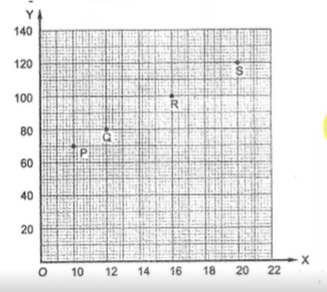P, Q, R are three collinear points. The coordinates of P and R are (3, 4) and (11, 10) respectively, and PQ is equal to 2.5 units. Coordinates of Q are
(5, 11/2)
(11, 5/2)
(5, -11/2)
(-5, 11/2)
The correct Answer is:A
To find the coordinates of point Q, we will follow these steps:
Step 1: Identify the coordinates of points P and R.
- The coordinates of point P are (3, 4).
- The coordinates of point R are (11, 10).
Step 2: Calculate the distance PR.
Using the distance formula:
d=√(x2−x1)2+(y2−y1)2
Substituting the coordinates of P and R:
d=√(11−3)2+(10−4)2
Calculating:
d=√(8)2+(6)2=√64+36=√100=10
So, the distance PR is 10 units.
Step 3: Find the midpoint S of segment PR.
The midpoint formula is:
Midpoint=(x1+x22,y1+y22)
Substituting the coordinates of P and R:
S=(3+112,4+102)=(142,142)=(7,7)
Step 4: Calculate the distance PS.
Using the distance formula again:
PS=√(7−3)2+(7−4)2
Calculating:
PS=√(4)2+(3)2=√16+9=√25=5
Step 5: Determine the distance PQ.
Given that PQ is equal to 2.5 units, we can find the position of Q relative to P and S.
Step 6: Find the coordinates of Q.
Since Q lies on the line segment PS, we can use the section formula. The distance from P to S is 5 units, and the distance from P to Q is 2.5 units. This means Q divides PS in the ratio 1:1 (because 2.5 is half of 5).
Using the section formula:
Q=(mx2+nx1m+n,my2+ny1m+n)
where m=1, n=1, (x1,y1)=(3,4), and (x2,y2)=(7,7):
Q=(1⋅7+1⋅31+1,1⋅7+1⋅41+1)=(7+32,7+42)=(102,112)=(5,5.5)
Conclusion:
The coordinates of point Q are (5, 5.5).
---
- The coordinates of point P are (3, 4).
- The coordinates of point R are (11, 10).
Using the distance formula:
d=√(x2−x1)2+(y2−y1)2
Substituting the coordinates of P and R:
d=√(11−3)2+(10−4)2
Calculating:
d=√(8)2+(6)2=√64+36=√100=10
So, the distance PR is 10 units.
The midpoint formula is:
Midpoint=(x1+x22,y1+y22)
Substituting the coordinates of P and R:
S=(3+112,4+102)=(142,142)=(7,7)
Using the distance formula again:
PS=√(7−3)2+(7−4)2
Calculating:
PS=√(4)2+(3)2=√16+9=√25=5
Given that PQ is equal to 2.5 units, we can find the position of Q relative to P and S.
Since Q lies on the line segment PS, we can use the section formula. The distance from P to S is 5 units, and the distance from P to Q is 2.5 units. This means Q divides PS in the ratio 1:1 (because 2.5 is half of 5).
Q=(mx2+nx1m+n,my2+ny1m+n)
where m=1, n=1, (x1,y1)=(3,4), and (x2,y2)=(7,7):
Q=(1⋅7+1⋅31+1,1⋅7+1⋅41+1)=(7+32,7+42)=(102,112)=(5,5.5)
The coordinates of point Q are (5, 5.5).
Topper's Solved these Questions
- BOOK - DISHA PUBLICATIONCHAPTER - COORDINATE GEOMETRYEXERCISE - EXPERT LEVEL28videos
COORDINATE GEOMETRY
- BOOK - DISHA PUBLICATIONCHAPTER - COORDINATE GEOMETRYEXERCISE - TEST YOURSELF15videos
COORDINATE GEOMETRY
- BOOK - DISHA PUBLICATIONCHAPTER - COORDINATE GEOMETRYEXERCISE - FOUNDATION LEVEL65videos
COORDINATE GEOMETRY
- BOOK - DISHA PUBLICATIONCHAPTER - AVERAGESEXERCISE - Test Yourself15videos
AVERAGES
- BOOK - DISHA PUBLICATIONCHAPTER - FUNCTIONSEXERCISE - Test Yourself15videos
FUNCTIONS
Similar Questions
Knowledge Check
- Question 1 - Select One
The coordinates of P and Q are (-3, 4) and (2, 1), respectively. If PQ is extended to R such that PR=2QR, then what are the coordinates of R ?
A(3, 7)B(2, 4)C(−12,52)D(7, -2) - Question 2 - Select One
The coordinates of P and Q are (- 3, 4) and (2, 1), respectively. If PQ is extended to R such that PR = 2QR, then what are the coordinates of R ?
A(3, 7)B(2, 4)C(−12,52)D(7,-2) - Question 3 - Select One
The coordinates of P and Q are (- 3, 4) and (2, 1), respectively. If PQ is extended to R such that PR = 2QR, then what are the coordinates of R ?
A(3 , 7)B(2 , 4)C(−12,52)D(7,−2)
The line segment joining the points (3, −4) and (1, 2) is trisected at the points P and Q . If the coordinates of P and Q are (p, −2) and (5/3, q) respectively. Find the values of p and q .
View SolutionFind the value of x such that PQ=QR where the coordinates of P, Q and R are (6, −1) , (1, 3) and (x, 8) respectively.
View SolutionFind the coordinates of points P, Q, R and S in Figure.
 View Solution
View SolutionIf P, Q and R are three non-collinear points, then what is PQ∩PR equal to?
View SolutionIn a cartesian coordinate system, the coordinates of two points P and Q are (2,3,-6) and (-2,-5,7) respectively, the vector ¯¯¯¯¯¯PQ is represented by
View Solution

